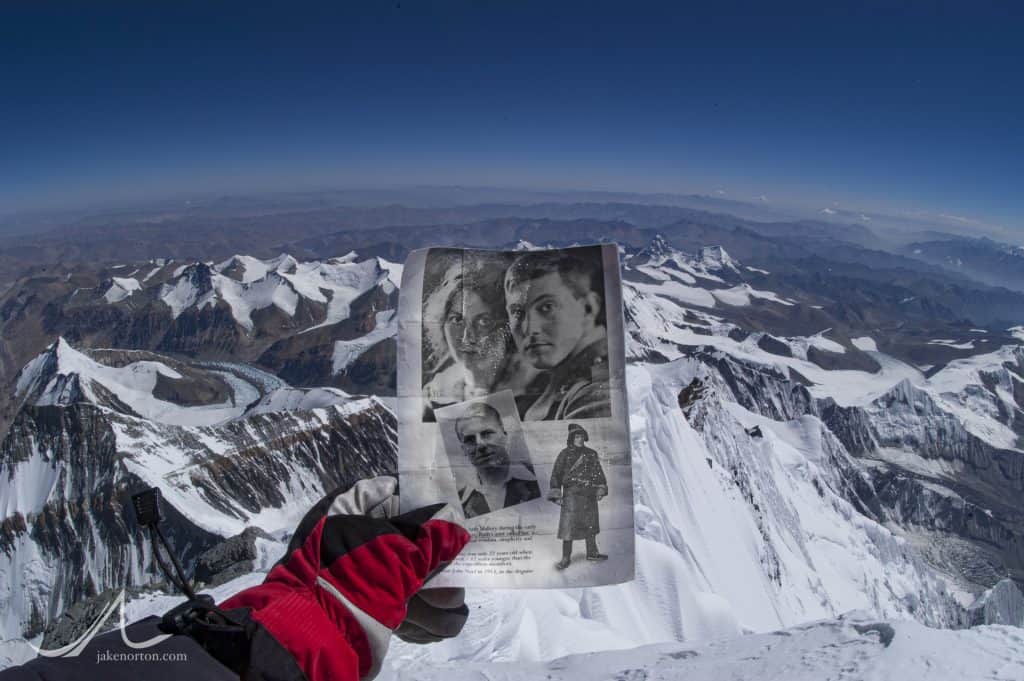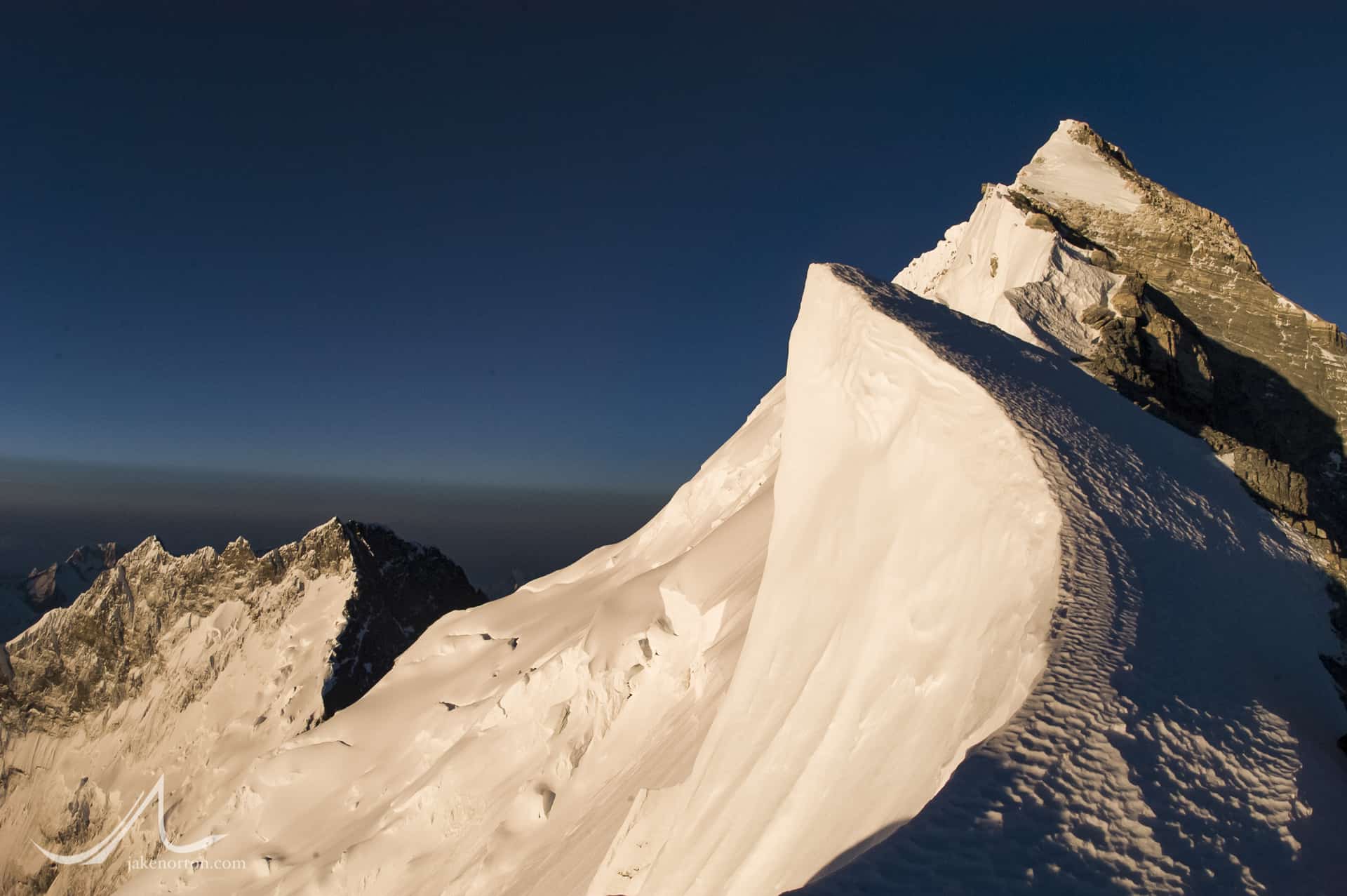
I’ve posted quite a bit on this blog about the enduring mystery of Everest pioneers George Mallory & Andrew Irvine, and have been fortunate enough to take an active role in the story, going to Everest in 1999, 2001, and 2004 to search for clues and answers to this greatest of mountaineering mysteries.
On that first expedition – the 1999 Mallory & Irvine Research Expedition – one of our team members was Graham Hoyland, the grand-nephew of Howard Somervell who was on the fateful 1924 Everest expedition. (Somervell reached nearly 28,000 feet without oxygen climbing with Teddy Norton on June 4, 1924, and also loaned Mallory his Kodak Vestpocket (VPK) camera for the final summit bid as Mallory had forgotten his at Basecamp.)
Unfortunately, in 1999, Graham fell ill with altitude sickness and was not able to take part directly in our discovery of Mallory’s remains on May 1. But, since then, he has taken a very active role in putting the pieces of the story together, including developing clothing replicas and returning to the mountain on several occasions.
Just this week, Graham has unveiled a new theory on Mallory & Irvine’s final summit bid and generated much media attention in the process in conjunction with a presentation to the Royal Geographic Society in London.
The crux of this theory, which puts Mallory & Irvine on the top of the world some 29 years before Hillary and Tenzin, hangs on Noel Odell’s final sighting of the pair high on the Northeast Ridge and conjecture that Mallory would have chosen to forgo the difficulties of the Second Step and climb instead below to the Third Step.
While I, like Graham, believe Mallory & Irvine could have reached the summit in 1924 (and I like to believe they did reach the top, a theory for which I have no proof), I doubt Graham’s new theory really breaks any ground.
If you take a good look at the panorama of the Northeast Ridge below – which shows the First, Second and Third Steps as well as the Summit Pyramid – you can see that bypassing the Second Step by traversing below it (which is the crux of Graham’s new theory) is not really a possibility. The daunting band of gray rock which forms the Second Step continues all the way to the Great Couloir with only a small gully breaking through just above the Second Step. And, given that this couloir is composed of down-sloping, rotten rock – characteristic of the upper North Face of Everest – I doubt this would be more feasible than the Second Step itself.
Indeed Teddy Norton, on his attempt on June 4, 1924 with Howard Somervell, traversed below the Northeast Ridge crest trying to find an alternate way to the summit. He found no viable break in the rock bands bypassing the Second Step, and was eventually turned around at 28,165 feet in the Great (Norton) Couloir.
Likewise, in 1933, Percy Wyn-Harris and Lawrence Wager eventually followed Norton’s traverse line after backing away from the Second Step and, as with Norton, found no viable passage through the gray band and onto the ridge crest. They turned around at nearly the same spot as Norton 9 years before. Days later, Eric Shipton and Frank Smythe tried the same route with the same results.
George Mallory was a great climber, skilled, insightful, and clever. But, Norton, Wyn-Harris, Wager, Shipton, and Smythe were no slouches and if they could not find a route through the gray band, I doubt Mallory & Irvine could have fared better.
So, while Graham’s theory is intriguing and brings this fascinating mystery back into the limelight, I unfortunately think it is but another theory. It unfortunately sheds no more true light on the story than Conrad Anker’s assertion that they could not have reached the top given the route challenges.
As I have maintained since 1999, we now know far more about their final days and hours than ever before, but we still have no proof…No proof that they did summit, and likewise no proof that they did not summit.
Anything proclaiming otherwise is simply conjecture.
What do you think?
Did Mallory & Irvine reach the top in 1924?
Does it matter?



Hello Jake,
Yes I agree with your assessment of the route leading to the Great Couloir and I’ve been following this story of late with interest.
Your comments on the rotten down sloping rock correlate with my own
observations based on your earlier zoom images you posted here in August from May 2004.
Both have been good in shedding light on the fine detail of the terrain, such as that deceptive gully past the second step which
Wyh-Harris & Wager tried to access in ’33.
Long suggested as a ‘backdoor’ up onto the plateau, 2004 imagery reveals to my eye, very steep holdless rock, arguably as bad as the second step itself.
To my eye, I simply can’t see a viable route from the couloir or its approaches up onto the plateau.
Moreover even if is was achieved by M&I, WHY would they proceed up onto the third step (veering far to the left as they angled up the plateau from the Couloir), when they could gain the base of the pyramid at any juncture.
Its seems excessive to veer so far over to the ridge crest when climbing up from the couloir and the pyramid looms above them accessable at any time.
Some suggest fear of avalanche, but if so, then surely one could just skirt the third step perimeter to the right and avoid the step itself or simply continue up the pyramid right ridge to the north pillar.
In note all pre war climbers tried to climb to the right and gain the subsidiary couloir too.
Finally, M&I #9 cylinder was found on the first step approaches at 8475m, this seems to indicate ‘a priori’ an intent to gain the NE Arete, but if the couloir theory is cogent, then it would mean that at some point M&I changed their minds and opted for the couloir, following the Wyn & Wager traverse for instance.
Possible but from my viewing of the terrain near and in the couloir, I’m somewhat sceptical.
Thanks for these good images.
Good health,
Phil
Let us remember this history, and answer our destiny and remake the world once again.
[name and email mis-typed in last posting attempt] Retry:
Jake,
Something occurred to me recently, something about the Second Step, and the embattled attempts to prove that M&I might have climbed it. Those like myself who believe that M&I (or at least Mallory) most likely reached the summit by a traverse of the North Face have sound reasons for thinking so. But any ¨planned route¨ can be changed on site, so no one knows which route was actually taken.Some believe that the NE Ridge and Steps may have been M&I´s preferred route. They may be right. Odell described the two figures appearing at the base of one of the Steps. One figure surmounted the Step ‘with alacrity’, and then the other did likewise. If this happened at the First or Third Step, or on any other rise along the Ridge except the Second Step, why didn’t they proceed roped together in single file, staying close to each other? Could it be that they climbed a ROPE to the top, which Mallory had set earlier, when still obscured by clouds, having free-climbed, with his consummate rock skills, the Second Step? He then would have descended the rope to test it, to convince Irvine, and to pick up his gear, left at the base of the Step, for the final ascent. Two climbers on the rope at once would have been hazardous, so they climbed separately, as Odell reported. Odell’s confusion about the Steps and his surprise at the late hour of M&I’s location now becomes understandable, as Mallory must have taken up several hours in performing the feat (like the Chinese in 1960). The seeming ‘synchronicity’ of Odell’s sighting with M&I´s climb of the Step was due simply to the opportune break in the weather. The late summiting, and the descent across the Yellow Band after dark, and the consequent mishap and fall now also become understandable.
S.I. Wells, 12 August 2021 https://cywelsian.wordpress.com/
Once again, thank you, Stewart, for your comment and out-of-the-box thinking.
On staying roped together between steps, I'm not sure we have any evidence that they did not stay roped on these portions. It does seem 99% certain (to me) that they were roped together in the final moments, given the rope tied to Mallory's waist, a bunch of it wrapped around his body, and evidence of a major shock (fall) to his torso. That said, as for remaining roped between steps (First to Second, and Second to Third), I could see them not remaining tied in on that terrain as it is (a) not altogether difficult, and (b) the likelihood of either arresting a fall of the other on that terrain would be minimal, thus making a roped fall a killer of two rather than "just" one.
As for fixing a line on the Second Step for ascent (and descent), this makes sense and certainly helps fit the scenario into Odell's final sighting. The challenge I see with it is the challenge of finding any suitable anchor atop the Second Step headwall upon which to anchor the rope. This is the biggest challenge I've long encountered in my thinking about the Second Step - not how they might've climbed up it, but how they could have gotten back down. But, there's always a chance there were different features there in 1924 - a boulder or horn of rock - that could've been used for an anchor. I do remember reading at one time that Mallory may have had some wooden chocks with him for protection - I can't remember where this possibility came from though. But, if he did, perhaps an anchor could have been made from those, but there are not great options for a trad anchor atop the Second Step.
Again, so many possibilities!
Hi Jake,
The Second Step success scenario would account for the 1960 Chinese expedition claim of finding a piece of rope, a stick, and two oxygen bottles above and beyond the Second Step. Messner and many others doubt this claim, and I am suspicious myself. If only the Chinese would produce the actual physical evidence! S.I. Wells, Donner Pass, 21 September 2021
Completely agree. I remember reading about those claims years ago. Do you know where those are referenced, Stewart? If true - and if they can provide any evidence for the claim - it certainly changes things quite a bit in my view.
So many possibilities indeed! like what happened to Mallory's ice axe? Did he jam the haft into a crack in the rock above the step as an anchor for the rope? was this the 'stick' reported by the Chinese? If so, what happened to the axe head? So many questions...
Questions, questions, questions, and so few answers. I'm with you 100%. Hard to know where his axe went, and yes, if it was the stick found by the Chinese, then what indeed happened to the head? And the spike? Hmm.
If the chinese did find something above the second step that would be astonishing and would seemingly confirm a ridge route. Would be interested in hearing more about this. Alex
Totally agree, Alex. As I mentioned, I do remember hearing of this years back, but cannot remember where, when, or from whom. I'll reach out to Jochen as well and see if he has thoughts on it all. It would certainly be a game changer if confirmed!